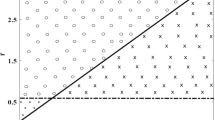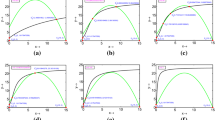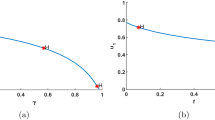Abstract
Studying predator–prey interactions with the help of mathematical modeling is helpful in understanding the mechanism, making informed decisions about their management and conservation, and estimating the behavior and dynamics of ecological systems. In this paper, we have explored the dynamics of a predator–prey model with the fear effect and Allee effect in prey and hunting cooperation in predator species. First, we prove the well-posedness of the system, which is followed by results related to the existence and stability of biologically feasible equilibrium points for the weak Allee effect as well as for the strong Allee effect. We have shown that the model exhibits a variety of bifurcations, including saddle-node, transcritical, and Hopf-bifurcation. Numerical simulation reveals that the conversion rate of predator plays an important role in the stability switching. It is observed that fear has both stabilizing and destabilizing effects depending on hunting cooperation and conversion efficiency of predators. The system experiences persistence or bistability for the weak Allee effect, whereas bistability and tristability are observed in the presence of strong Allee effect. We found that as the hunting cooperation increases, the density of prey species reduces. On the other hand, moderate cooperation is beneficial with the strong Allee effect, but the high level of hunting cooperation may force one or both species to become extinct. However, for the weak Allee effect, when the conversion rate of predators is greater than the mortality rate, system cannot collapse even with the high amount of hunting cooperation. Therefore, the theoretical and numerical results of our paper may provide some useful biological insight to estimate the behavior of species and may have a potential impact on population management.









Similar content being viewed by others
Data availability
Not applicable.
References
Allee, W., Bowen, E.S.: Studies in animal aggregations: mass protection against colloidal silver among goldfishes. J. Exp. Zool. 61(2), 185–207 (1932)
Allee, W., Wilder, J.: Group protection for Euplanaria dorotocephala from ultra-violet radiation. Physiol. Zool. 12(2), 110–135 (1939)
Altendorf, K.B., Laundré, J.W., González, C.A.L., Brown, J.S.: Assessing effects of predation risk on foraging behavior of mule deer. J. Mammal. 82(2), 430–439 (2001)
Alves, M.T., Hilker, F.M.: Hunting cooperation and allee effects in predators. J. Theor. Biol. 419, 13–22 (2017)
Arancibia-Ibarra, C., Gonzalez-Olivares, E.: A modified Leslie–Gower predator-prey model with hyperbolic functional response and Allee effect on prey. In: BIOMAT 2010 International Symposium on Mathematical and Computational Biology, pp. 146–162 (2011)
Arancibia-Ibarra, C., Flores, J.D., Pettet, G., Van Heijster, P.: A Holling–Tanner predator–prey model with strong allee effect. Int. J. Bifurc. Chaos 29(11), 1930032 (2019)
Beddington, J.R.: Mutual interference between parasites or predators and its effect on searching efficiency. J. Anim. Ecol. 44(1), 331–340 (1975)
Berec, L.: Impacts of foraging facilitation among predators on predator–prey dynamics. Bull. Math. Biol. 72(1), 94–121 (2010)
Berec, L., Angulo, E., Courchamp, F.: Multiple allee effects and population management. Trends Ecol. Evol. 22(4), 185–191 (2007)
Brown, J.S., Laundré, J.W., Gurung, M.: The ecology of fear: optimal foraging, game theory, and trophic interactions. J. Mammal. 80(2), 385–399 (1999)
Cong, P., Fan, M., Zou, X.: Dynamics of a three-species food chain model with fear effect. Commun. Nonlinear Sci. Numer. Simul. 99, 105809 (2021)
Cosner, C., DeAngelis, D.L., Ault, J.S., Olson, D.B.: Effects of spatial grou** on the functional response of predators. Theor. Popul. Biol. 56(1), 65–75 (1999)
Courchamp, F., Berec, L., Gascoigne, J.: Allee Effects in Ecology and Conservation. OUP, Oxford (2008)
Creel, S., Christianson, D.: Relationships between direct predation and risk effects. Trends Ecol. Evol. 23(4), 194–201 (2008)
Cresswell, W.: Predation in bird populations. J. Ornithol. 152(1), 251–263 (2011)
Davies, A.B., Cromsigt, J.P., Tambling, C.J., Le Roux, E., Vaughn, N., Druce, D.J., Marneweck, D.G., Asner, G.P.: Environmental controls on African herbivore responses to landscapes of fear. Oikos 130(2), 171–186 (2021)
Ddumba, H., Mugisha, J., Gonsalves, J.W., Kerley, G.: The role of predator fertility and prey threshold bounds on the global and local dynamics of a predator–prey model with a prey out-flux dilution effect. Appl. Math. Comput. 218(18), 9169–9186 (2012)
DeAngelis, D.L., Goldstein, R., O’Neill, R.V.: A model for tropic interaction. Ecology 56(4), 881–892 (1975)
Deppe, A.M., Kushnick, G.: Olfactory predator recognition in the brown mouse lemur (Microcebus rufus) in Ranomafana National Park, Madagascar. Am. J. Primatol. 82(10), e23184 (2020)
Dhooge, A., Govaerts, W., Kuznetsov, Y.A., Meijer, H.G.E., Sautois, B.: New features of the software MatCont for bifurcation analysis of dynamical systems. Math. Comput. Model. Dyn. Syst. 14(2), 147–175 (2008)
González-Olivares, E., Cabrera-Villegas, J., Córdova-Lepe, F., Rojas-Palma, A.: Competition among predators and allee effect on prey, their influence on a Gause-type predation model. Math. Probl. Eng. 1–19, 2019 (2019)
Grinnell, J., Packer, C., Pusey, A.E.: Cooperation in male lions: kinship, reciprocity or mutualism? Anim. Behav. 49(1), 95–105 (1995)
Hastings, A.: Population Biology: Concepts and Models. Springer Science & Business Media, New York (2013)
Hearn, G.W., Berghaier, R.W., George, D.D.: Evidence for social enhancement of reproduction in two Eulemur species. Zoo Biol. (Published in affiliation with the American Zoo and Aquarium Association) 15(1), 1–12 (1996)
Holling, C.S.: The components of predation as revealed by a study of small-mammal predation of the European pine sawfly1. Can. Entomol. 91(5), 293–320 (1959)
Holling, C.S.: Some characteristics of simple types of predation and parasitism. Can. Entomol. 91(7), 385–398 (1959)
Huang, J., Ruan, S., Song, J.: Bifurcations in a predator–prey system of Leslie type with generalized Holling type III functional response. J. Differ. Equ. 257(6), 1721–1752 (2014)
Huang, Y., Zhu, Z., Li, Z.: Modeling the allee effect and fear effect in predator–prey system incorporating a prey refuge. Adv. Differ. Equ. 2020(1), 1–13 (2020)
Hutson, V.: A theorem on average Liapunov functions. Monatsh. Math. 98(4), 267–275 (1984)
Hutson, V.: The existence of an equilibrium for permanent systems. Rocky Mt. J. Math. 20(4), 1033–1040 (1990)
Kooij, R.E., Zegeling, A.: Qualitative properties of two-dimensional predator–prey systems. Nonlinear Anal. Theory Methods Appl. 29(6), 693–715 (1997)
Kot, M.: Elements of Mathematical Ecology. Cambridge University Press, Cambridge (2001)
Kuang, Y., Freedman, H.: Uniqueness of limit cycles in Gause-type models of predator–prey systems. Math. Biosci. 88(1), 67–84 (1988)
Lotka, A.J.: Elements of Physical Biology. Williams & Wilkins, Baltimore (1925)
Lührs, M.-L., Dammhahn, M.: An unusual case of cooperative hunting in a solitary carnivore. J. Ethol. 28, 379–383 (2010)
May, R.M.: Limit cycles in predator–prey communities. Science 177(4052), 900–902 (1972)
Mondal, N., Barman, D., Alam, S.: Impact of adult predator incited fear in a stage-structured prey–predator model. Environ. Dev. Sustain. 23(6), 9280–9307 (2021)
Mukherjee, D.: Role of fear in predator–prey system with intraspecific competition. Math. Comput. Simul. 177, 263–275 (2020)
Murray, J.D.: Mathematical Biology: I. An Introduction. Springer, Berlin (2002)
Pal, S., Majhi, S., Mandal, S., Pal, N.: Role of fear in a predator–prey model with Beddington–Deangelis functional response. Z. Nat. A 74(7), 581–595 (2019)
Pal, S., Pal, N., Samanta, S., Chattopadhyay, J.: Effect of hunting cooperation and fear in a predator–prey model. Ecol. Complex. 39, 100770 (2019)
Pal, S., Pal, N., Samanta, S., Chattopadhyay, J.: Fear effect in prey and hunting cooperation among predators in a Leslie–Gower model. Math. Biosci. Eng. 16(5), 5146–5179 (2019)
Perko, L.: Differential Equations and Dynamical Systems. Springer, New York (2001)
Qiao, T., Cai, Y., Fu, S., Wang, W.: Stability and Hopf bifurcation in a predator–prey model with the cost of anti-predator behaviors. Int. J. Bifurc. Chaos 29(13), 1950185 (2019)
Ripple, W.J., Larsen, E.J.: Historic aspen recruitment, elk, and wolves in northern Yellowstone National Park, USA. Biol. Conserv. 95(3), 361–370 (2000)
Sasmal, S.K.: Population dynamics with multiple allee effects induced by fear factors—a mathematical study on prey–predator interactions. Appl. Math. Model. 64, 1–14 (2018)
Sasmal, S.K., Takeuchi, Y.: Dynamics of a predator–prey system with fear and group defense. J. Math. Anal. Appl. 481(1), 123471 (2020)
Sen, M., Banerjee, M.: Rich global dynamics in a prey-predator model with allee effect and density dependent death rate of predator. Int. J. Bifurc. Chaos 25(03), 1530007 (2015)
Sen, M., Banerjee, M., Takeuchi, Y.: Influence of allee effect in prey populations on the dynamics of two-prey-one-predator model. Math. Biosci. Eng. 15(4), 883 (2018)
Seo, G., DeAngelis, D.L.: A predator-prey model with a Holling type I functional response including a predator mutual interference. J. Nonlinear Sci. 21(6), 811–833 (2011)
Shang, Z., Qiao, Y.: Bifurcation analysis of a Leslie-type predator-prey system with simplified Holling type IV functional response and strong allee effect on prey. Nonlinear Anal. Real World Appl. 64, 103453 (2022)
Stander, P.E.: Cooperative hunting in lions: the role of the individual. Behav. Ecol. Sociobiol. 29(6), 445–454 (1992)
Stephens, P.A., Sutherland, W.J., Freckleton, R.P.: What is the allee effect? Oikos 87(1), 185–190 (1999)
Sugie, J., Kohno, R., Miyazaki, R.: On a predator-prey system of Holling type. Proc. Am. Math. Soc. 125(7), 2041–2050 (1997)
Suraci, J.P., Clinchy, M., Dill, L.M., Roberts, D., Zanette, L.Y.: Fear of large carnivores causes a trophic cascade. Nat. Commun. 7(1), 10698 (2016)
Van Voorn, G.A., Hemerik, L., Boer, M.P., Kooi, B.W.: Heteroclinic orbits indicate overexploitation in predator-prey systems with a strong allee effect. Math. Biosci. 209(2), 451–469 (2007)
Vishwakarma, K., Sen, M.: Role of allee effect in prey and hunting cooperation in a generalist predator. Math. Comput. Simul. 190, 622–640 (2021)
Vishwakarma, K., Sen, M.: Influence of allee effect in prey and hunting cooperation in predator with Holling type-III functional response. J. Appl. Math. Comput. 68, 249–269 (2022)
Volterra, V.: Variazioni e fluttuazioni del numero d’individui in specie animali conviventi, vol. 2. Societá anonima tipografica" Leonardo da Vinci" (1927)
Wang, J., Cai, Y., Fu, S., Wang, W.: The effect of the fear factor on the dynamics of a predator–prey model incorporating the prey refuge. Chaos 29(8), 083109 (2019)
Wang, X., Tan, Y., Cai, Y., Wang, W.: Impact of the fear effect on the stability and bifurcation of a Leslie–Gower predator–prey model. Int. J. Bifurc. Chaos 30(14), 2050210 (2020)
Wang, X., Zanette, L., Zou, X.: Modelling the fear effect in predator–prey interactions. J. Math. Biol. 73(5), 1179–1204 (2016)
Wang, X., Zou, X.: Modeling the fear effect in predator–prey interactions with adaptive avoidance of predators. Bull. Math. Biol. 79(6), 1325–1359 (2017)
Wiggins, S., Wiggins, S., Golubitsky, M.: Introduction to Applied Nonlinear Dynamical Systems and Chaos, vol. 2. Springer, Berlin (2003)
**e, B., Zhang, N.: Influence of fear effect on a Holling type-III prey–predator system with the prey refuge. AIMS Math. 7(2), 1811–1830 (2022)
Zanette, L.Y., White, A.F., Allen, M.C., Clinchy, M.: Perceived predation risk reduces the number of offspring songbirds produce per year. Science 334(6061), 1398–1401 (2011)
Zhang, H., Cai, Y., Fu, S., Wang, W.: Impact of the fear effect in a prey–predator model incorporating a prey refuge. Appl. Math. Comput. 356, 328–337 (2019)
Acknowledgements
The work of first author is supported by Council of Scientific and Industrial Research (CSIR) under Grant Number: 09/1023(0038)/2020-EMR-I. The authors are thankful to the anonymous referees for their valuable suggestions which has significantly improved the manuscript.
Author information
Authors and Affiliations
Corresponding author
Ethics declarations
Conflict of interest
The authors have no conflicts of interest to disclose.
Additional information
Publisher's Note
Springer Nature remains neutral with regard to jurisdictional claims in published maps and institutional affiliations.
Rights and permissions
Springer Nature or its licensor (e.g. a society or other partner) holds exclusive rights to this article under a publishing agreement with the author(s) or other rightsholder(s); author self-archiving of the accepted manuscript version of this article is solely governed by the terms of such publishing agreement and applicable law.
About this article
Cite this article
Umrao, A.K., Srivastava, P.K. Bifurcation Analysis of a Predator–Prey Model with Allee Effect and Fear Effect in Prey and Hunting Cooperation in Predator. Differ Equ Dyn Syst (2023). https://doi.org/10.1007/s12591-023-00663-w
Accepted:
Published:
DOI: https://doi.org/10.1007/s12591-023-00663-w




